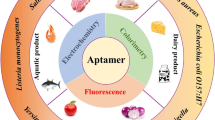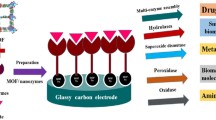Abstract
A “signal off” aptasensor has been developed to detect deoxynivalenol (DON). DON aptamers (Apt) were used as biological recognition elements, nickel ferrite nanotubes (NiFe2O4 NTs) are used as the base material to increase the surface area of the electrode, and the Au@Pt NRs were used as carriers for loading signal labels thionine (Thi) and complementary strand (cDNA). In the presence of DON it will be specifically captured by Apt, then the competition mechanism was triggered; the signal molecules fall off from the electrode surface, which then causes the electrode signal to decrease. NiFe2O4 NTs and Au@Pt NRs were characterized by transmission electron microscope (TEM), scanning electron micrograph (SEM), energy-dispersive X-ray spectroscopy (EDS), and X-ray diffraction (XRD). The designed sensor provides a concentration range of 1 × 10−8 to 5 × 10−4 mg mL−1 and limit of detection of 3.02 × 10−9 mg mL−1. Determination of DON in corn meal samples was investigated and the recovery was 98.4 to 103.5%. The proposed aptasensor displayed good sensitivity, high specificity, and acceptable reproducibility.

Based on NiFe2O4 NTs as substrate material and Au@Pt NRs as signal label prepared DON aptasensor for the determination of DON.





Similar content being viewed by others
References
Morooka N, Uratsuji N, Yoshizawa T, Yamamoto H (1972) Studies on the toxic substances in barley infected with Fusarium spp. J Food Hyg Soc Jpn 13(5):368–375
Krysinska-Traczyk E, Perkowski J, Dutkiewicz J (2007) Levels of fungi and mycotoxins in the samples of grain and grain dust collected from five various cereal crops in eastern Poland. Ann Agric Environ Med 14(1):159–167
Rodriguez-Carrasco Y, Carlos Molto J, Manes J, Berrada H (2014) Development of a GC-MS/MS strategy to determine 15 mycotoxins and metabolites in human urine. Talanta 128:125–131
Fromme H, Gareis M, Voelkel W, Gottschalk C (2016) Overall internal exposure to mycotoxins and their occurrence in occupational and residential settings - an overview. Int J Hyg Environ Health 219(2):143–165
De Colli L, Elliott C, Finnan J, Grant J, Arendt EK, McCormick SP, Danaher M (2020) Determination of 42 mycotoxins in oats using a mechanically assisted QuEChERS sample preparation and UHPLC-MS/MS detection. J Chromatogr B-Anal Technol Biomed Life Sci 1150:122187
Huang X, Huang T, Li X, Huang Z (2020) Flower-like gold nanoparticles-based immunochromatographic test strip for rapid simultaneous detection of fumonisin B-1 and deoxynivalenol in Chinese traditional medicine. J Pharm Biomed Anal 177:112895
Kos J, Hajnal EJ, Malachova A, Steiner D, Stranska M, Krska R, Poschmaier B, Sulyok M (2020) Mycotoxins in maize harvested in Republic of Serbia in the period 2012-2015. Part 1: Regulated mycotoxins and its derivatives. Food Chem 312:126034
Tegegne WA, Mekonnen ML, Beyene AB, Su W-N, Hwang B-J (2020) Sensitive and reliable detection of deoxynivalenol mycotoxin in pig feed by surface enhanced Raman spectroscopy on silver nanocubes@polydopamine substrate. Spectrochim Acta A-Mol Biomol Spectrosc 229:117940
Urusov AE, Gubaidullina MK, Petrakova AV, Zherdev AV, Dzantiev BB (2018) A new kind of highly sensitive competitive lateral flow immunoassay displaying direct analyte-signal dependence. Application to the determination of the mycotoxin deoxynivalenol. Microchim Acta 185(1):29
Xu Y, Zhang W, Shi J, Li Z, Huang X, Zou X, Tan W, Zhang X, Hu X, Wang X, Liu C (2020) Impedimetric aptasensor based on highly porous gold for sensitive detection of acetamiprid in fruits and vegetables. Food Chem 322:126762
Wei Z, Sun X, Li Z, Fang Y, Ren G, Huang Y, Liu J (2011) Highly sensitive deoxynivalenol immunosensor based on a glassy carbon electrode modified with a fullerene/ferrocene/ionic liquid composite. Microchim Acta 172(3–4):365–371
Khan R, Sherazi TA, Catanante G, Rasheed S, Marty JL, Hayat A (2020) Switchable fluorescence sensor toward PAT via CA-MWCNTs quenched aptamer-tagged carboxyfluorescein. Food Chem 312:126048
Tuerk C, Gold L (1990) Systematic evolution of ligands by exponential enrichment: RNA ligands to bacteriophage T4 DNA polymerase. Science (New York, NY) 249(4968):505–510
Goud KY, Reddy KK, Satyanarayana M, Kummari S, Gobi KV (2020) A review on recent developments in optical and electrochemical aptamer-based assays for mycotoxins using advanced nanomaterials. Microchim Acta 187(29):1–32
Sahin S, Caglayan MO, Uestuendag Z (2020) Recent advances in aptamer-based sensors for breast cancer diagnosis: special cases for nanomaterial-based VEGF, HER2, and MUC1 aptasensors. Microchim Acta 187(10):1–27
Liu C-S, Li J, Pang H (2020) Metal-organic framework-based materials as an emerging platform for advanced electrochemical sensing. Coord Chem Rev 410:213222
Wang L, Wang Z, Xie L, Zhu L, Cao X (2019) ZIF-67-derived N-doped Co/C Nanocubes as high-performance anode materials for lithium-ion batteries. ACS Appl Mater Interfaces 11(18):16619–16628
Li J, Wei H, Peng Y, Geng L, Zhu L, Cao X-Y, Liu C-S, Pang H (2019) A multifunctional self-healing G-PyB/KCl hydrogel: smart conductive, rapid room-temperature phase-selective gelation, and ultrasensitive detection of alpha-fetoprotein. Chem Commun 55(55):7922–7925
Zhu L, Wang Z, Wang L, Xie L, Li J, Cao X (2019) ZnSe embedded in N-doped carbon nanocubes as anode materials for highperformance Li-ion batteries. Chem Eng J 364:503–513
Hou H, Banks CE, Jing M, Zhang Y, Ji X (2015) Carbon quantum dots and their derivative 3D porous carbon frameworks for sodium-ion batteries with ultralong cycle life. Adv Mater 27(47):7861–7866
Chen S, Liu P, Su K, Li X, Qin Z, Xu W, Chen J, Li C, Qiu J (2018) Electrochemical aptasensor for thrombin using co-catalysis of hemin/G-quadruplex DNAzyme and octahedral Cu2O-Au nanocomposites for signal amplification. Biosens Bioelectron 99:338–345
Wang Y-H, Xia H, Huang K-J, Wu X, Ma Y-Y, Deng R, Lu Y-F, Han Z-W (2018) Ultrasensitive determination of thrombin by using an electrode modified with WSe2 and gold nanoparticles, aptamer-thrombin-aptamer sandwiching, redox cycling, and signal enhancement by alkaline phosphatase. Microchim Acta 185(11):502
Wang F-T, Wang Y-H, Xu J, Huang K-J (2020) A high-energy sandwich-type self-powered biosensor based on DNA bioconjugates and a nitrogen doped ultra-thin carbon shell. J Mater Chem B 8(7):1389–1395
Ganie AS, Bano S, Sultana S, Sabir S, Khan MZ (2020) Ferrite Nanocomposite based electrochemical sensor: characterization, voltammetric and amperometric studies for electrocatalytic detection of formaldehyde in aqueous Media. Electroanalysis
Darabi R, Shabani-Nooshabadi M (2021) NiFe2O4-rGO/ionic liquid modified carbon paste electrode: an amplified electrochemical sensitive sensor for determination of sunset yellow in the presence of Tartrazine and Allura Red. Food Chem 339:127841–127841
Fang D, Li J, Huang D, Dai H, Lin Y (2020) Dual-modality probe based on black phosphorous and NiFe2O4 NTs for electrochemiluminescence and photothermal detection of ovarian cancer marker. Talanta 211:120660
Bindu K, Nagaraja HS (2019) Influence of cations in MFe2O4 (M: Fe, Zn, Ni, Sn) ferrite nanoparticles on the electrocatalytic activity for application in hydrogen peroxide sensor. Mater Res Express 6(9):095015
Zhong H, Yu C, Gao R, Chen J, Yu Y, Geng Y, Wen Y, He J (2019) A novel sandwich aptasensor for detecting T-2 toxin based on rGO-TEPA-Au@Pt nanorods with a dual signal amplification strategy. Biosens Bioelectron 144:111635
Liu J, Hu X, Hou S, Wen T, Liu W, Zhu X, Yin J-J, Wu X (2012) Au@Pt core/shell nanorods with peroxidase- and ascorbate oxidase-like activities for improved detection of glucose. Sensors Actuators B-Chem 166:708–714
Alijani HQ, Pourseyedi S, Torkzadeh-Mahani M, Seifalian A, Khatami M (2020) Bimetallic nickel-ferrite nanorod particles: greener synthesis using rosemary and its biomedical efficiency. Artificial Cells Nanomed Biotechnol 48(1):242–251
Peng Y, Geng L, Liu X, Liu M, Wu H, Li J (2019) A label-free small molecular hydrogel-based electrochemical immunosensor for ultrasensitive detection of deoxynivalenol. Anal Methods 11(47):5948–5952
Qing Y, Li C, Yang X, Zhou X, Xue J, Luo M, Xu X, Chen S, Qiu J (2016) Electrochemical immunosensor using single-walled carbon nanotubes/chitosan for ultrasensitive detection of deoxynivalenol in food samples. J Appl Electrochem 46(10):1049–1057
Valera E, Garcia-Febrero R, Elliott CT, Sanchez-Baeza F, Marco MP (2019) Electrochemical nanoprobe-based immunosensor for deoxynivalenol mycotoxin residues analysis in wheat samples. Anal Bioanal Chem 411(9):1915–1926
Radi A-E, Eissa A, Wandan T (2019) Impedimetric sensor for deoxynivalenol based on electropolymerised molecularly imprinted polymer on the surface of screen-printed gold electrode. Int J Environ Anal Chem 2019(6):1–12
Li X, Zhu P, Liu C, Pang H (2019) One step synthesis of boron-doped carbon nitride derived from 4-pyridylboronic acid as biosensing platforms for assessment of food safety. Chem Commun 55(62):9160–9163
Funding
This work was financially supported by the National Natural Science Foundation of China (Grant No. 61301037), the Program for Science and Technology Innovation Talents in Universities of Henan Province (No. 20HASTIT002), the Cultivation Plan for Young Core Teachers in Universities of Henan Province (No. 2017GGJS072), and the National Engineering Laboratory for Wheat & Corn Further Processing, Henan University of Technology (No. NL2018004).
Author information
Authors and Affiliations
Corresponding author
Ethics declarations
Conflict of interest
The author(s) declare that they have no competing interests.
Additional information
Publisher’s note
Springer Nature remains neutral with regard to jurisdictional claims in published maps and institutional affiliations.
Supplementary Information
ESM 1
(DOCX 228 kb)
Rights and permissions
About this article
Cite this article
He, B., Wang, K. A “signal off” aptasensor based on NiFe2O4 NTs and Au@Pt NRs for the detection of deoxynivalenol via voltammetry. Microchim Acta 188, 23 (2021). https://doi.org/10.1007/s00604-020-04666-0
Received:
Accepted:
Published:
DOI: https://doi.org/10.1007/s00604-020-04666-0




